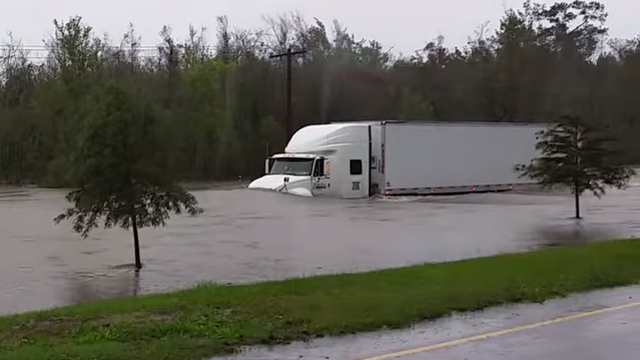This article provides only a general overview of post-flood guidance.
A major flooding event can have significant impacts on the safety and reliability of a trucking company’s vehicles. Here are some steps a trucking company can take to ensure their vehicles are safe after a major flooding event:
Fresh-Water Flooding Guidelines
Start by thoroughly power-washing the vehicle, making sure to include the undercarriage and wheel ends if you are confident the power unit or trailer was submerged in fresh water.
When cleaning, exercise caution: The high-pressure jet shouldn’t be used to directly spray rubber components or sealing interfaces. Direct spraying of exhaust ports by a high-pressure sprayer may result in irreversible damage to valves and/or corrosion to internal parts.
It is advised to wear the proper personal protection equipment (PPE) when washing or working on flooded vehicles, whether they are submerged in fresh or salt water. Most valves leave the delivery open to the atmosphere at the exhaust port in their unapplied state, therefore if any exhaust port is inundated, water has entered the system and could cause future malfunction.
Valves and Internal Components
- Examine each part of the auxiliary and pneumatic brake systems.
- Release any residual pressure in the service reservoirs.
- At each valve, label and unplug any electrical and pneumatic connectors for drying.
- Inspect the air hoses, couplings, and components for signs of water or pollution.
- Carefully blow air through the pneumatic tubes and hoses using dry compressed air pressure (from a stationary compressor or a similar source). Keep an eye out for signs of contamination or water.
- Replace the components containing water or other contaminants.
- Reassemble the components to the related lines and fittings if no signs of water or pollution are discovered.
For more information on air braking systems, read our article “Air Brakes on CMVs – How they work & regulations you need to know”
Charging Systems
- Check for indications of water or pollutant ingestion in and around the battery box, alternator, and connecting cables and ground connections.
- Carefully blow air through the components that may be hiding water. (Be careful not to use too much pressure or you could damage copper coils or wires).
- To remove any remaining water from the service tanks, blow it out with dry compressed air using a stationary air compressor (or a suitable portable one).
- Ensure ground connections and other major connections are free of rust or residue (This is a very important step as it commonly leads to vehicle breakdowns).
Wheel-Ends & Electronics
Check all wheel ends for water, which can pool in drums when left standing, increasing the risk of corrosion between the material of the drum lining and the shoe surface. The integrity of the friction pair between the shoe and the drum must also be examined by a professional technician. Although water-filled loading docks might not be thought of as “flood events,” they can still have a similar effect on various wheel-end parts, such as slack adjusters and brake chambers.
To make sure that water hasn’t gotten into brake chambers through any air lines, a professional technician will have to inspect the components for any irregularities following post-flood guidance materials.
Utilizing a program like Bendix ACom Pro software, Technicians can do a diagnostic download on systems like ABS, ESC (electronic stability control), and collision mitigation controllers, including any front or side radar units, to evaluate the braking functionality. In most circumstances, electronic devices will validate by self-check and activate a warning light if a problem is found. The essential solenoids, sensors, harnesses, etc. will be checked if the electronic control unit (ECU) is functional. Make sure to also examine the electrical connector that connects the truck to the trailer.
Two Bendix Technical Bulletins that are useful for putting tractors and trailers back into service after they have been submerged are available for additional extensive reference in the Bendix Document Library at bendix.com.
- Flood Damage: Bendix Recommendations for Controlling Potentially Submerged Trailer and Dolly Systems (TCH-003-048).
- Flood Damage: Bendix Recommended Procedure for Potentially Submerged Power Vehicles (TCH-003-049).
Getting back on the road
Before putting the unit back into operation, thoroughly test the air brake system and ABS. If your inspections reveal no signs of water or pollution. Be aware that the power washing and flooding may have caused the ABS wheel speed sensors to shift from their usual location. By manually bringing them back into contact with the exciter ring, you can force the sensor position adjustment while the wheel rotates. Wheel Speed Sensors are a very common fault found on vehicles even without ever being submerged so you might consider replacing them proactively.



